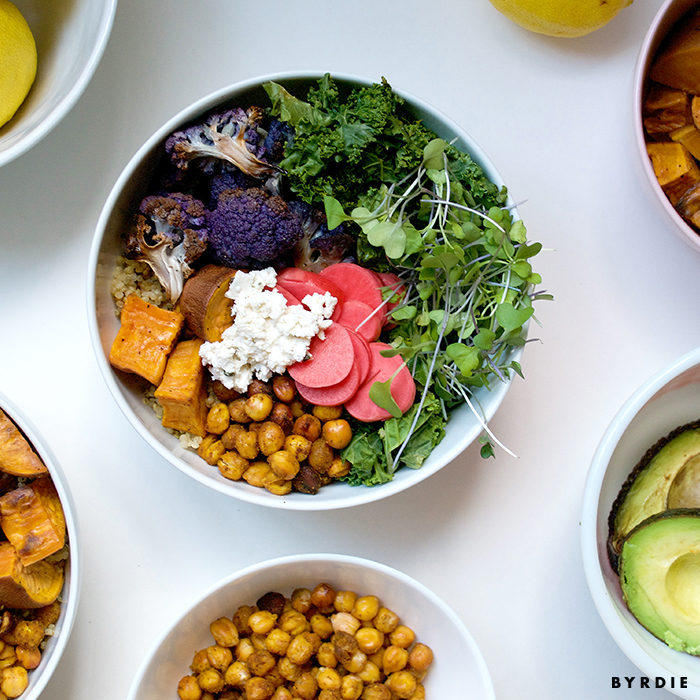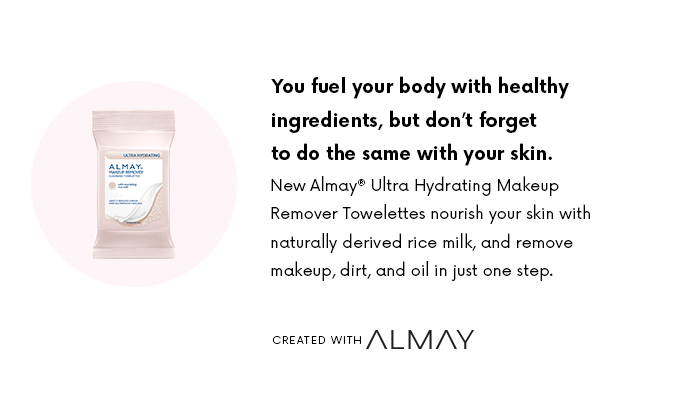How to Build a Highly Instagrammable (and Highly Nutritious) Rainbow Bowl

When I first began cooking for myself, I used to scour the internet for different recipes, bookmarking my findings into highly organized virtual folders. These days, my process is increasingly low-maintenance, but nonetheless thoughtful: Seduced by images of colorful farmers market produce and stunningly crafted (yet entirely accessible) plant-based meals, I find myself emulating the handiwork of Instagram foodies in my own kitchen. Social media is hardly the most positive influence in my life, but by encouraging me to feast with my eyes, it has—rather ironically—inspired me to be more mindful in the way I prepare my meals.
And what better way to appreciate the beauty of different ingredients than to put them on full display? That's likely the reason rainbow bowls have become so popular on IG as of late So named for its aesthetically pleasing array of colors, the rainbow bowl isn't so much a "recipe" as an invitation to throw a bunch of your favorite healthy ingredients together for an endlessly customizable and well-balanced meal.
It's hard to discuss the trend's rise without mentioning Lee Tilghman, also known as @leefromamerica—her very popular Instagram feed, which boasts artfully crafted bowls of all kinds and arguably put this kind of colorful eating on the social media map. It certainly doesn't hurt that Tilghman herself seems to exude the same kind of vibrancy as the farmers market produce she photographs.
Because it's not just about aesthetics—the name "rainbow bowl" alone serves as a helpful exercise in eating nutritiously. "Especially when it comes to vegetables, variety is great," explains New York City–based nutritionist Amy Shapiro. "The colors provide different nutrients, vitamins and antioxidants. Getting a variety helps protect you from a variety of possible illnesses." To that end, it's a great exercise in really getting to know your ingredients from a wellness lens—which, in turn, helps you mindfully select the best components for a truly balanced bowl.
Beyond that, there's certainly practical appeal as well. As someone who cannot bring herself to cook on weeknights, I often get bored eating the same leftovers day after day. By prepping a bunch of different bowl ingredients on Sunday, I give myself the flexibility to toss different combos together all week long, which means I really can eat according to my mood—no Postmates necessary.
It's totally simple in practice, but there are some important things to keep in mind if you're looking to create a nutritionally balanced bowl. Keep reading for Tilghman's and Shapiro's pointers—from the proper ratio of macros to the best way to meal-prep.
Build your bowl
Ideally, your bowl should feature a good balance of complex carbohydrates, veggies, protein, and healthy fat, says Shapiro. Consider her go-to formula for serving sizes:
- Fill 1/2 the bowl with greens and other veggies.
- Fill 1/4 of the bowl with protein—about 4 or 5 ounces.
- Fill the last 1/4 of the bowl with complex carbs—about 1/3 cup.
- Add 1 to 2 servings of healthy fat—1 serving is 1 tablespoon oil, or 1/4 of an avocado.
Those four elements are your general baseline—the fun part is choosing your ideal ingredients in each category. As for meal prep, Tilghman likes to put aside time each weekend to prepare a bunch of different bowl ingredients that she can choose from throughout the week. "I'll usually pick up produce from the farmers market on Sunday and spend the day roasting veggies, making a big batch of bean dip or pesto, and prepping out my protein," she says. "Definitely clean as you go and start small when it comes to meal prep—better to not have enough than to waste lots!"
Again, the ingredients themselves and the way you prepare them are totally up to you, so don't be afraid to get creative with different flavors and spices. Use the ideas below—courtesy of Shapiro, Tilghman, and us—to get you started.
Veggies
- greens: kale, spinach, or chard
- broccolini, sautéed in olive oil with garlic
- cauliflower, roasted
- sprouts or microgreens
- radishes
- sauerkraut or kimchi
- shredded carrot
- mushrooms, sautéed
- bok choy
- cauliflower rice

Protein
- chicken breast
- ahi tuna (for your own take on a poke bowl)
- baked tofu
- wild salmon
- a "naked" veggie burger
- fried egg
Complex carbohydrates
- quinoa
- brown rice
- chickpeas, roasted in coconut oil and curry powder
- black bean dip
- sweet potato, roasted
- lentils
- wild rice
- farro
Healthy Fats
- avocado
- olive oil vinaigrette
- tahini
- toasted sesame seeds
- goat cheese (or Kite Hill's vegan soft cheese)
- chopped walnuts
- peanut butter dressing
- flaxseed
Ready for assembly?
Pick and choose your preferred combo of ingredients, and artfully arrange it as you please. For a truly 'grammable moment, be mindful of the dishes you use—Tilghman recommends colorful ceramics—and consider organizing each ingredient by color since that appears to be a very double tap–worthy aesthetic. And, as always, lighting is everything. Now post away and dig in as the likes roll in.
Next up: Your body "type" probably isn't what you think.
Disclaimer
This article is provided for informational purposes only and is not intended to be used in the place of advice of your physician or other medical professionals. You should always consult with your doctor or healthcare provider first with any health-related questions.
